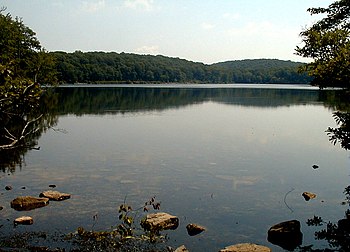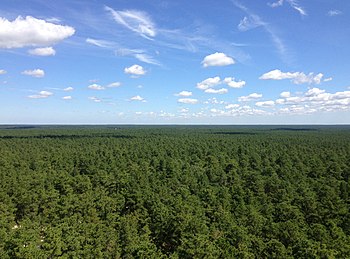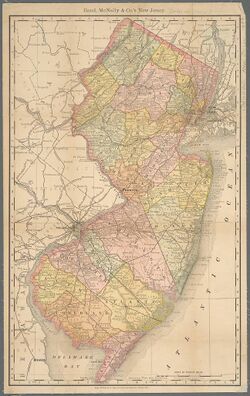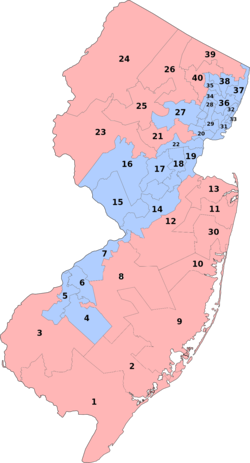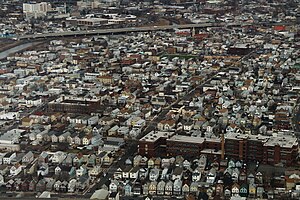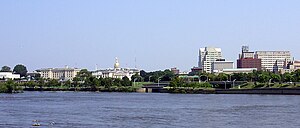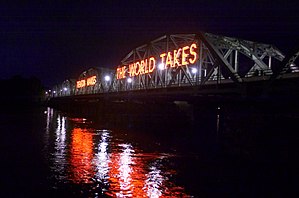New Jersey (U.S. state): Difference between revisions
Pat Palmer (talk | contribs) |
mNo edit summary |
||
| (9 intermediate revisions by one other user not shown) | |||
| Line 15: | Line 15: | ||
== Bordered by water bodies == | == Bordered by water bodies == | ||
New Jersey's northern border with [[New York (U.S. state)|New York state]] is a straight line across land, but otherwise, New Jersey is surrounded by water on three sides, like a peninsula: | New Jersey's northern border with [[New York (U.S. state)|New York state]] is a short, straight line across rather rugged land, but otherwise, New Jersey is surrounded by water on three sides, like a peninsula: | ||
* On the west, its border is the [[Wikipedia:Delaware River|Delaware River]], across from [[Pennsylvania (U.S. state)|Pennsylvania]] and, in the south central part, Philadelphia. | * On the west, its border is the [[Wikipedia:Delaware River|Delaware River]], across from [[Pennsylvania (U.S. state)|Pennsylvania]] and, in the south central part, Philadelphia. | ||
* On the south, its border is the [[Wikipedia:Delaware Bay|Delaware Bay]], across from [[Delaware (U.S. state)|Delaware]]. | * On the south, its border is the [[Wikipedia:Delaware Bay|Delaware Bay]], across from [[Delaware (U.S. state)|Delaware]]. | ||
| Line 37: | Line 37: | ||
The state has a population with diverse origins, with about 20% Hispanic, 12% African American, and 10% Asian (and about half of those Indian, or South Asian), along with a wide variety of other ethnicities and nationalities. The state also has a substantial American Jewish population. About a third of adults in the state identify as Catholic, another third as Protestant, and the remaining third prefer other world religions or have agnostic or atheistic leanings.<ref name=Relig /> | The state has a population with diverse origins, with about 20% Hispanic, 12% African American, and 10% Asian (and about half of those Indian, or South Asian), along with a wide variety of other ethnicities and nationalities. The state also has a substantial American Jewish population. About a third of adults in the state identify as Catholic, another third as Protestant, and the remaining third prefer other world religions or have agnostic or atheistic leanings.<ref name=Relig /> | ||
In 2020, the state's voting population passed a public question<ref name=MJ /> that amended the state constitution to legalize [[marijuana]] and erase past legal convictions for possession. The measure passed by a two-thirds vote. At the time the measure was enacted, about a dozen other U.S. states had also legalized the sale and possession of marijuana. As of 2024, local governments and municipalities are still in the process of regulating marijuana-related businesses within their jurisdictions. | |||
==Image slideshow== | ==Image slideshow== | ||
| Line 42: | Line 44: | ||
Line3174 - Shipping Containers at the terminal at Port Elizabeth, New Jersey - NOAA.jpg|Port Elizabeth, NJ contains acres of shipping containers. | Line3174 - Shipping Containers at the terminal at Port Elizabeth, New Jersey - NOAA.jpg|Port Elizabeth, NJ contains acres of shipping containers. | ||
Elizabeth, New Jersey - Aerial I (43861389542).jpg|New Jersey is the most densely populated U.S. state. This is an aerial view of Elizabeth, NJ, from 2014. | Elizabeth, New Jersey - Aerial I (43861389542).jpg|New Jersey is the most densely populated U.S. state. This is an aerial view of Elizabeth, NJ, from 2014. | ||
2009-08-17 View of downtown Trenton in New Jersey and the mouth of the Assunpink Creek from across the Delaware River in Morrisville, Pennsylvania.jpg|Downtown [[Trenton, New Jersey|Trenton]], and the mouth of Assunpink Creek, as viewed from across the Delaware River in Morrisville, Pennsylvania in 2009. | |||
Trentonmakesnight.jpg|The Lower [[Trenton, New Jersey|Trenton]] Bridge over the [[Delaware River]], by which Amtrak and local trains cross from Trenton into [[Pennsylvania (U.S. state)|Pennsylvania]], is visible to automobile traffic crossing the river on U.S. Route 1. For many years, one of the letters of the sign "Trenton Makes, the World Takes" was burned out and was finally replaced in 2016 immediately before [[Donald Trump]] visited the city. | |||
</gallery> | </gallery> | ||
| Line 70: | Line 74: | ||
</ref> | </ref> | ||
</references> | <ref name=MJ> | ||
[https://ballotpedia.org/New_Jersey_Public_Question_1,_Marijuana_Legalization_Amendment_(2020) New Jersey Public Question 1, Marijuana Legalization Amendment (2020)] on Ballotpedia.org, last access 2/26/2024. | |||
</ref> | |||
</references>[[Category:Suggestion Bot Tag]] | |||
Latest revision as of 11:00, 25 September 2024
New Jersey is a small, densely-populated state in the northeast U.S., named after the Channel Island of Jersey. Its capital city Trenton is centrally located and lies on the Delaware River across from the northeastern corner of Philadelphia.
Urban vs. rural
In its middle, the state has an urban corridor running from Philadelphia northwest to New York City. Broadcast media in the state come from either or both cities, and state-wide political campaigns must target both markets. This urban belt tends to be more liberal and to vote Democrat, whereas the more suburban and rural areas tend to be more conservative and to vote Republican.[1] The state capital is Trenton, which is close to Philadelphia.
New Jersey has the highest population density in the nation[2], and yet its state motto "The Garden State" is reflected by the presence of numerous farms and wooded lands, despite dense suburban sprawl in some areas. There are numerous protected parks, including a segment of the Appalachian Trail in the northwest corner of the state near the Delaware Water Gap, the New Jersey Pine Barrens in the south, and various preserved woods and wetlands throughout the state.
Bordered by water bodies
New Jersey's northern border with New York state is a short, straight line across rather rugged land, but otherwise, New Jersey is surrounded by water on three sides, like a peninsula:
- On the west, its border is the Delaware River, across from Pennsylvania and, in the south central part, Philadelphia.
- On the south, its border is the Delaware Bay, across from Delaware.
- On the southeast shoulder, its border is the Atlantic Ocean.
- On the northeast shoulder, its border is the Raritan Bay and the Hudson River, across from New York City.
Historic battle grounds
New Jersey was one of the original thirteen colonies which broke away from Britain in 1776 to form the U.S. It has several important historic battlefield sites preserved since the American Revolution, including the site where George Washington crossed the Delaware River for a surprise attack on Trenton on Christmas night of 1776, and sites for the Battle of Trenton, the Battle of Princeton, and the Battle of Monmouth.
Superfund sites
Due to past industrial activity, New Jersey has more Superfund toxic waste sites than any other state in the union—and this despite its small geographic size. Only 35 of New Jersey's Superfund sites (out of about 150 that have been on the EPA’s list since the Superfund law was passed in 1980) have actually been cleaned up. People have real reasons to be concerned about the quality of drinking water in the Garden State. As of 2024, New Jersey still has 115 priority Superfund sites.
What it's like to live in NJ
A state sales tax of 6.625% might be considered high, except for the fact that essential items such as food, clothing, drugs, and manufacturing machinery are exempt, and certain struggling urban areas pay even less tax. These features mean it can be said to be a "progressive" sales tax.[3].
There are strict gun registration laws (no open carry).
Residential land is scarce, and property taxes tend to be high relative to other parts of the United States. Rental housing rates are high.
As of 2022, all aspects of reproductive choice (including abortion) are protected by law.[4]
The state has a population with diverse origins, with about 20% Hispanic, 12% African American, and 10% Asian (and about half of those Indian, or South Asian), along with a wide variety of other ethnicities and nationalities. The state also has a substantial American Jewish population. About a third of adults in the state identify as Catholic, another third as Protestant, and the remaining third prefer other world religions or have agnostic or atheistic leanings.[5]
In 2020, the state's voting population passed a public question[6] that amended the state constitution to legalize marijuana and erase past legal convictions for possession. The measure passed by a two-thirds vote. At the time the measure was enacted, about a dozen other U.S. states had also legalized the sale and possession of marijuana. As of 2024, local governments and municipalities are still in the process of regulating marijuana-related businesses within their jurisdictions.
Image slideshow
See also
References
- ↑ The state has recently had governors from both parties (and as of 2023, the governor is a Democrat). The two state senators are typically Democrats. Most (but not all) of the U.S. congressional representatives are Democrats.
- ↑ In 2020, the state average was 1,134 people per square mile, whereas the sparsest state (Montana) averaged a mere 7 people per square mile.
- ↑ The sales tax rate is from 2023. In addition to excluding essential items, certain towns also charge less sales tax--those designated as Urban Enterprise Zones have their sales tax rate cut in half. In 2022, these zones existed in parts of Elizabeth, Bridgeton, Camden, Newark, Trenton, Plainfield, New Brunswick and Gloucester City, all of which lie in the urban belt between Philadelphia and New York City.
- ↑ Text of the reproductive choice law passed by NJ in 2022, from the state of NJ website, last access 12/9/2022
- ↑ Religious Landscape of New Jersey since 2000, by Pew Research.
- ↑ New Jersey Public Question 1, Marijuana Legalization Amendment (2020) on Ballotpedia.org, last access 2/26/2024.
